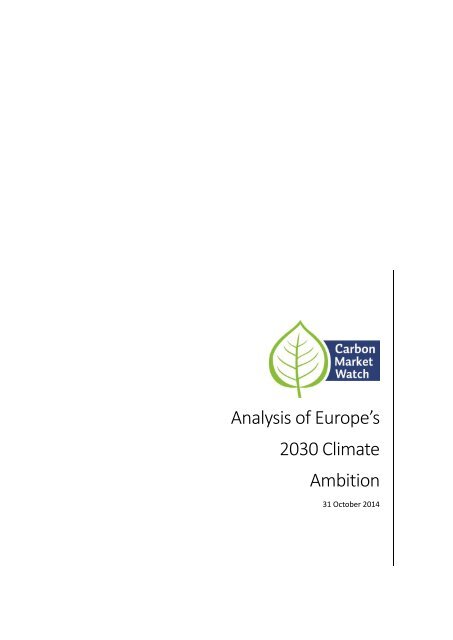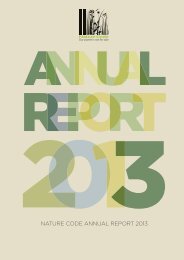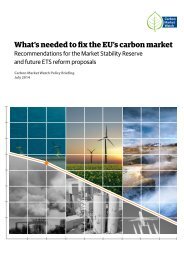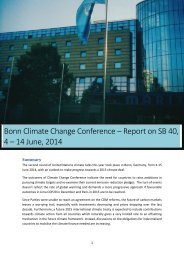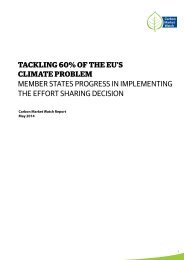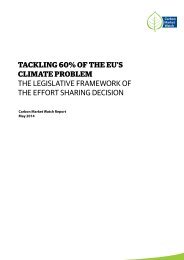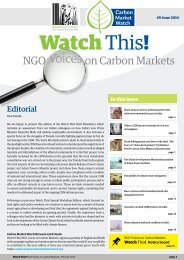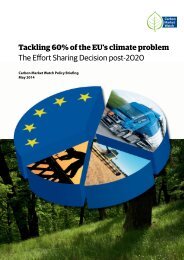Analysis of Europe’s 2030 Climate Ambition
Create successful ePaper yourself
Turn your PDF publications into a flip-book with our unique Google optimized e-Paper software.
<strong>Analysis</strong> <strong>of</strong> <strong>Europe’s</strong><br />
<strong>2030</strong> <strong>Climate</strong><br />
<strong>Ambition</strong><br />
31 October 2014
Introduction<br />
During the night <strong>of</strong> 23 October 2014, EU leaders have brokered a deal on the <strong>2030</strong> climate and energy<br />
headline targets. EU’s Heads <strong>of</strong> States settled on an EU-binding renewable energy target <strong>of</strong> at least 27%,<br />
an indicative energy efficiency target <strong>of</strong> at least 27% and an at least 40% binding domestic greenhouse<br />
gas reduction target by <strong>2030</strong>.<br />
This deal setting out <strong>Europe’s</strong> future climate ambition has to be seen in the wider political context <strong>of</strong><br />
the international climate negotiations that are expected to deliver a global climate deal at the climate<br />
summit in Paris next year. The EU is one <strong>of</strong> the first in announcing its pledge for the future climate treaty,<br />
providing momentum for the rest <strong>of</strong> the world to follow suit. However, the EU’s climate target fails to<br />
be in line with the EU’s fair contribution to tackling climate change which would entail around 55%<br />
domestic emission cuts. This lack <strong>of</strong> ambition is largely caused by the current difficult political and<br />
economic climate landscape: The economic crisis has reduced the political willingness to adopt policies<br />
that are either seen as expensive or have a potential impact on industry’s competitiveness.<br />
Euroscepticism, on the other hand, has put a strain on the regulatory powers <strong>of</strong> the EU, favoring an<br />
(over)reliance on markets instead.<br />
Although the <strong>2030</strong> climate and energy package is centered around the greenhouse gas reduction target<br />
with little support from the renewable energy and energy efficiency pillars, a positive decision was to<br />
keep the option open <strong>of</strong> increasing the <strong>2030</strong> climate target at a later stage. But this outcome which<br />
required all 28 Member States to agree came at a price: Concessions were made to some countries in<br />
the form <strong>of</strong> energy subsidies and new flexibility instruments. Poland was the most vocal country<br />
threatening to use its veto to block the deal in case it was not sufficiently compensated financially.<br />
Poland succeeded in ensuring that its coal-dominated energy sector will remain shielded from the<br />
carbon price also in the future. Poland also ensured access to new subsidies by establishing a<br />
modernization fund that could potentially be used to extend the lifespan <strong>of</strong> its existing coal power<br />
plants. At the same, more wealthy countries with relatively high national reduction targets demanded<br />
new flexibility instruments to make sure they would not be faced with high costs. A new flexibility option<br />
was borne that allows these countries to buy allowances from the oversupplied carbon market in order<br />
to <strong>of</strong>fset emissions in the transport, building and agriculture sectors.<br />
In a nutshell, key highlights <strong>of</strong> decisions on the <strong>2030</strong> climate and energy framework include:<br />
1. A binding target to reduce domestic greenhouse gas emissions by at least 40% by <strong>2030</strong>,<br />
possibly resulting in only 31% effective emission reductions<br />
2. A possible revision <strong>of</strong> the EU’s pledge after the climate summit in Paris next year, opening<br />
doors for the EU to increase its climate ambition and participate in the international carbon<br />
market<br />
3. Flexibilities to help achieve Member States’ targets for the non-ETS sectors, including<br />
<strong>of</strong>fsetting non-ETS emissions with EU ETS allowances<br />
4. Continuation <strong>of</strong> free allocation <strong>of</strong> emission allowances to industry, worth €120-€300 billion<br />
5. Inclusion <strong>of</strong> land use, land use change and forestry (LULUCF) into the climate framework<br />
6. Financial support to the power sector in low-income states, including free allowances to<br />
power plants worth up to €11-€16.5 billion and a modernization fund worth €6-€9 billion<br />
See below a more detailed analysis <strong>of</strong> these decisions and possible next steps:<br />
1
1. A binding target to reduce domestic greenhouse gas emissions by at<br />
least 40% by <strong>2030</strong><br />
The <strong>2030</strong> council conclusions read:<br />
2. The European Council endorsed a binding EU target <strong>of</strong> an at least 40% domestic reduction in<br />
greenhouse gas emissions by <strong>2030</strong> compared to 1990. To that end:<br />
2.1 the target will be delivered collectively by the EU in the most cost-effective manner possible, with<br />
the reductions in the ETS and the non-ETS sectors amounting to 43% and 30% by <strong>2030</strong> compared to<br />
2005, respectively;<br />
2.2 all Member States will participate in this effort, balancing considerations <strong>of</strong> fairness and solidarity;<br />
2.3 a well-functioning, reformed Emissions Trading System (ETS) with an instrument to stabilize the<br />
market in line with the Commission proposal will be the main European instrument to achieve this<br />
target; the annual factor to reduce the cap on the maximum permitted emissions will be changed from<br />
1.74% to 2.2% from 2021 onwards;<br />
Impact <strong>of</strong> surplus on the 40% target<br />
Up to 4.5 billion excess emission permits in the EU’s carbon market<br />
<strong>Europe’s</strong> carbon market is currently not functioning properly due to an oversupply <strong>of</strong> emission<br />
allowances equaling more than 2 billion, which has depressed the carbon price to a historic low level.<br />
By 2020, the surplus is expected to<br />
accumulate to 2.6-4.5 billion excess<br />
emission permits 1 . The surplus is the<br />
result <strong>of</strong> a combination <strong>of</strong> factors,<br />
including the large inflow <strong>of</strong> international<br />
carbon <strong>of</strong>fset, EU’s weak 2020 target that<br />
is out <strong>of</strong> line with a least cost pathway to<br />
achieve the 2050 decarbonisation<br />
objective and the economic recession.<br />
EU leaders decided that the EU’s<br />
Emissions Trading System with a Market<br />
Stability Reserve will be the “main<br />
instrument” to achieve the <strong>2030</strong> climate<br />
target, but failed to call for permanent<br />
removal <strong>of</strong> the excess emission permits<br />
by 2020. The 2.6-4.5 billion surplus under<br />
the EU ETS could sabotage <strong>Europe’s</strong> climate efforts for decades to come, as the excess allowances are<br />
automatically carried-over into the <strong>2030</strong> climate framework. This could contaminate the proposed 40%<br />
climate target by watering down the effective reduction to only 24%-31%. The graph on the right by<br />
Carbon Brief explains how the surplus <strong>of</strong> carbon allowances could lead to increased <strong>2030</strong> emissions.<br />
1.3 billion surplus emission permits in EU countries<br />
In addition to the surplus accumulated under the EU ETS, a considerable amount <strong>of</strong> excess emission<br />
allowances under the Effort Sharing Decision (ESD) will also build up in the current climate framework.<br />
The ESD, EU’s second climate instrument, sets out yearly reduction targets for each country for those<br />
1<br />
The European Commission (2014) estimates that the surplus will reach 2.6 billion allowances by 2020. More<br />
recent estimates by the UK government (2014) and Sandbag (2014) show an even higher oversupply <strong>of</strong> 3.1 and<br />
4.5 billion allowances by 2020.<br />
2
sectors not covered by the EU ETS and as such, covers more than 60% <strong>of</strong> the EU’s emissions. By the year<br />
2020, European countries are expected to have accumulated around 1.3 billion unused allowances<br />
under the ESD. This is due to two reasons:<br />
(i) The weak 2020 targets leading to a surplus <strong>of</strong> around 600 million tonnes <strong>of</strong> CO 2-eq 2 as actual<br />
greenhouse gas emissions are predicted to remain below the EU’s targets in each year during<br />
the 2013-2020 period.<br />
(ii) The use <strong>of</strong> up to 750 million<br />
international <strong>of</strong>fsets until<br />
2020 3 , since EU Member<br />
States can purchase more<br />
than half <strong>of</strong> their overall<br />
reduction obligations<br />
through carbon credits from<br />
<strong>of</strong>fsetting projects in<br />
developing countries.<br />
Contrary to the surplus emission<br />
allowances under the EU ETS, which<br />
will be carried-over automatically,<br />
the ESD does not foresee banking <strong>of</strong><br />
these pre-2020 surplus allowances<br />
for future use, unless explicitly<br />
decided otherwise. The Council conclusions don’t explicitly open doors for this option which can be<br />
interpreted as a very welcome step to safeguard the <strong>2030</strong> target from an additional loophole on top <strong>of</strong><br />
the excess allowances from the EU ETS.<br />
There was a considerable threat that the EU leaders would decide to allow banking <strong>of</strong> pre-2020 surplus<br />
allowances, because several countries, such as Poland, Hungary, Czech Republic, Slovakia, Bulgaria and<br />
Romania actively advocated for this. These countries, commonly referred to as “Visegrad+2 countries”,<br />
are projected to overachieve their 2020 targets, leaving them with a considerable amount <strong>of</strong> unused<br />
pre-2020 allowances. Allowing them and the other EU countries to use these “rights to pollute” in the<br />
<strong>2030</strong> climate framework, would have watered down the <strong>2030</strong> climate target by 5%.<br />
Postponing most <strong>of</strong> the climate action until later<br />
The European Council reconfirmed in February 2011 the EU’s objective <strong>of</strong> reducing greenhouse gas<br />
emissions by 80-95% by 2050 compared to 1990. Today’s decision by the EU leaders calls for a 40%<br />
reduction <strong>of</strong> greenhouse gas<br />
emissions between the 1990-<strong>2030</strong><br />
period and a further 40% emission<br />
reduction between the period <strong>2030</strong>-<br />
2050. See also the graph on the right<br />
by Ec<strong>of</strong>ys (2014) showing that the<br />
<strong>2030</strong> climate target <strong>of</strong> 40% is not on<br />
a linear reduction pathway from 2020<br />
to 2050. In other words: under the<br />
proposed emission reductions <strong>of</strong> 40%<br />
or less by <strong>2030</strong>, efforts need to<br />
heavily accelerate after <strong>2030</strong> to<br />
2<br />
European Commission (April 2014), Technical Annex to Kyoto <strong>Ambition</strong> Mechanism Report<br />
3<br />
European Environment Agency (2013). Trends and projections in Europe 2013<br />
3
achieve 80-95% emission reductions by 2050. Most <strong>of</strong> the climate action is hence postponed until later<br />
as the average annual reduction effort has to double in the period <strong>2030</strong>-2050 compared to 2010-<strong>2030</strong>.<br />
Next steps<br />
At the beginning <strong>of</strong> this year, the European Commission proposed to establish a Market Stability Reserve<br />
to address the problems with the oversupplied carbon market. It is now in the hands <strong>of</strong> the European<br />
Parliament and the Council to amend and agree on this legislative proposal.<br />
In the course <strong>of</strong> 2015, the European Commission is furthermore expected to come forward with<br />
legislation to implement the <strong>2030</strong> climate target, in particular:<br />
- A proposal to revise the EU ETS directive to implement the <strong>2030</strong> target for the ETS sectors,<br />
including a proposal to increase the linear reduction factor by which the cap on ETS emissions is<br />
reduced each year.<br />
- A proposal for new legislation that specifies the annual binding targets for the non-ETS sectors<br />
in each country to implement the <strong>2030</strong> target.<br />
Carbon Market Watch Recommendations<br />
For the EU ETS revision:<br />
- The linear reduction factor by which the cap on EU ETS emissions is reduced each year will need<br />
to increase to 2.6% or more 4 to bring the EU’s <strong>2030</strong> climate target in line with a linear pathway<br />
to the objective to reduce greenhouse gas emissions by 80-95% by 2050.<br />
- The next trading period <strong>of</strong> the EU ETS needs to be shortened to 5 years (2021-2025) so as to<br />
avoid locking in the EU in a high-carbon pathway for years to come.<br />
For the new legislation governing the emissions <strong>of</strong> the non-ETS sectors:<br />
- The annual reduction <strong>of</strong> the overall cap on non-ETS emissions needs to be made consistent with<br />
a linear reduction pathway to the objective to reduce greenhouse gas emissions by 80-95% by<br />
2050.<br />
For the Market Stability Reserve proposal:<br />
- The surplus emission allowances under the EU ETS needs to be permanently removed in order<br />
to ensure that the proposed 40% climate target is not watered down.<br />
2. Possible revision <strong>of</strong> EU’s climate pledge after the 2015 climate summit<br />
The <strong>2030</strong> council conclusions read:<br />
1. […] On the basis <strong>of</strong> the principles identified in the March 2014 European Council conclusions, the<br />
European Council agreed today on the <strong>2030</strong> climate and energy framework for the European Union.<br />
Accordingly, the EU will submit its contribution, at the latest by the first quarter <strong>of</strong> 2015, in line with<br />
the timeline agreed by the UNFCCC in Warsaw for the conclusion <strong>of</strong> a global climate agreement. The<br />
European Council calls on all countries to come forward with ambitious targets and policies well in<br />
advance <strong>of</strong> the Conference <strong>of</strong> the Parties 21 in Paris. It will revert to this issue after the Paris<br />
Conference. […]<br />
4<br />
See Carbon Market Watch’s policy briefing on the EU ETS.<br />
4
The role <strong>of</strong> the EU at international climate negotiations<br />
EU leaders kept doors open to revise the EU’s pledge after the climate summit in Paris next year where<br />
a future international climate treaty to replace the Kyoto Protocol is expected. The world has been<br />
watching the EU as it is the first major emitter to come forward with a climate target. The decision<br />
therefore provides some momentum towards the Paris 2015 global climate agreement. However, the<br />
EU’s proposed climate target is not in line with the EU’s fair contribution to tackling climate change 5<br />
which would be in the order <strong>of</strong> at least 55% greenhouse gas emission reductions. Scaling up climate<br />
ambition is therefore necessary in the near future to be able to limit global warming below 2°C. The<br />
decision to possibly increase the EU’s climate target in the context <strong>of</strong> the international climate<br />
negotiations is hence an important and much hoped for element in the package.<br />
Future prospects <strong>of</strong> linking emissions trading systems<br />
Despite moving away from allowing international <strong>of</strong>fsets as part <strong>of</strong> the 40% GHG target, the EU is still<br />
dedicated to establish a global carbon market and is heavily involved in various initiatives, including the<br />
World Bank’s Partnership for Market Readiness.<br />
The possible revision <strong>of</strong> the EU’s climate target beyond 40% emission reductions therefore also has to<br />
be seen within this context as it opens up a future EU role in global carbon markets. This is an important<br />
element for certain EU countries that have historically had a high stake in carbon markets, such as<br />
Germany, the UK, Sweden, the Netherlands and others who have explicitly stated in the international<br />
climate negotiations that a liquid international carbon market with sufficient demand can promote costeffective<br />
abatement and stimulate mitigation ambition towards our shared 2°C objective. Opening doors<br />
for the EU to remain a player in international carbon markets is also seen by some countries as an<br />
important element in their international relations with third countries.<br />
The EU and Switzerland are currently negotiating the possibility <strong>of</strong> linking their emissions trading<br />
systems. At the same time, more and more countries have implemented or are in the process <strong>of</strong><br />
implementing an emissions trading scheme. China for example expects to roll-out a national carbon<br />
market by 2016.<br />
Linking the EU’s carbon market with emissions trading schemes outside <strong>of</strong> Europe opens the question<br />
how these “foreign” allowances are to be treated as part <strong>of</strong> <strong>Europe’s</strong> 40% GHG target. Although the<br />
nature <strong>of</strong> the GHG target has been decided as “domestic”, some stakeholders have implied that linking<br />
<strong>of</strong> carbon markets could fall within the scope <strong>of</strong> the 40% GHG target.<br />
Future role <strong>of</strong> international UNFCCC market mechanisms in the EU<br />
In the run up to the 2015 Paris climate negotiations, international carbon market rules are being<br />
negotiated at international level. The EU is particularly active in establishing a New Market Mechanism<br />
(NMM) and a so called Framework for Various Approaches (FVA) which is expected to put rules in place<br />
for the transfer <strong>of</strong> emission units between different emissions trading schemes and <strong>of</strong>fset markets. Next<br />
to the importance <strong>of</strong> setting up an international accounting framework to avoid double counting, a key<br />
issue is to agree on criteria and in particular on the level <strong>of</strong> ambition to allow countries to use markets<br />
to count towards their commitments.<br />
There is a common understanding that the EU’s domestic 40% climate target does not provide sufficient<br />
momentum to create demand for new market mechanisms for two reasons: 1) 40% is not in line with<br />
EU’s linear decarbonisation pathway up to 2050 and hence does not set a positive step that could be<br />
considered as “ambitious” 2) it excludes the use <strong>of</strong> international carbon <strong>of</strong>fsets, units or allowances by<br />
establishing a binding domestic GHG target.<br />
5<br />
See Ec<strong>of</strong>ys (2014), Assessing the EU <strong>2030</strong> <strong>Climate</strong> and Energy targets: A briefing paper<br />
5
Therefore those EU Member States that want to be able to use international carbon units (from existing<br />
Kyoto <strong>of</strong>fsetting mechanisms or the new market mechanism) have an interest in increasing EU’s<br />
domestic 40% target. For more information on the current experience <strong>of</strong> the use <strong>of</strong> international <strong>of</strong>fsets<br />
in EU’s 2020 climate legislation see our policy briefing.<br />
Next steps<br />
As part <strong>of</strong> the international climate negotiations, the European Parliament, the Council and the<br />
European Commission will discuss increasing EU’s climate ambition beyond the 40% domestic<br />
reductions.<br />
Furthermore, the negotiations on linking the EU ETS with the Swiss ETS are still ongoing and might be<br />
finalized in the next year(s).<br />
Carbon Market Watch Recommendations<br />
- The EU should adopt a climate target <strong>of</strong> at least 55% domestic emission reductions by <strong>2030</strong>.<br />
The EU’s international leadership role will depend on meaningful steps to increase ambition<br />
ahead <strong>of</strong> this Paris climate summit. Increasing <strong>Europe’s</strong> climate ambition ahead <strong>of</strong> this climate<br />
summit could incentivize other countries to step up their climate efforts too, leading to a race<br />
to the top that could increase our chances <strong>of</strong> avoiding dangerous climate change.<br />
As part <strong>of</strong> the EU ETS revision:<br />
- The EU ETS directive should include linking safeguards to ensure that linking does not<br />
compromise the domestic nature and the integrity <strong>of</strong> the EU’s <strong>2030</strong> climate target. Unless the<br />
foreign carbon market fully complies with all the rules and the ambition level <strong>of</strong> the EU ETS,<br />
allowing the use <strong>of</strong> allowances from a non-EU country for compliance under the EU ETS should<br />
not fall within the scope <strong>of</strong> EU’s “domestic” emission reductions. The European Parliament<br />
should furthermore also be involved in the discussion around linking the EU ETS with other<br />
carbon markets: Currently the European Commission negotiates linking with other emissions<br />
trading systems on the Council’s behalf.<br />
3. Flexibilities to help achieve Member States’ targets for the non-ETS<br />
sectors<br />
The <strong>2030</strong> council conclusions read:<br />
2.12 the availability and use <strong>of</strong> existing flexibility instruments within the non-ETS sectors will be<br />
significantly enhanced in order to ensure cost-effectiveness <strong>of</strong> the collective EU effort and convergence<br />
<strong>of</strong> emissions per capita by <strong>2030</strong>. A new flexibility in achieving targets – for Member States with<br />
national reduction targets significantly above both the EU average and their cost-effective reduction<br />
potential as well as for Member States that did not have free allocation for industrial installations in<br />
2013 – will be established through a limited, one-<strong>of</strong>f, reduction <strong>of</strong> the ETS allowances, to be decided<br />
before 2020, while preserving predictability and environmental integrity;<br />
Countries fear the relatively high costs for meeting their <strong>2030</strong> reductions required in sectors not covered<br />
by the EU’s ETS, such as transport, agriculture, buildings and waste. This is especially the case for those<br />
countries with a relatively high economic output per inhabitant, as the efforts <strong>of</strong> the <strong>2030</strong> target will be<br />
distributed on the basis <strong>of</strong> relative Gross Domestic Product (GDP) per capita. This basically means that<br />
more wealthy countries will be faced with more ambitious climate targets than poorer ones. The<br />
national <strong>2030</strong> targets for each country will span from 0% to -40% compared to 2005, and adjusted for<br />
Member States with a GDP per capita above the EU average to also reflect cost-effectiveness.<br />
6
The use <strong>of</strong> flexibilities could help Member States to reach their climate targets against less costs. But<br />
contrary to the existing 2020 climate target, the new <strong>2030</strong> climate target does not allow for the use <strong>of</strong><br />
international <strong>of</strong>fsets from reductions in developing countries. To compensate for the lack <strong>of</strong><br />
international flexibilities, EU’s leaders settled on enhancing the current intra-EU trading options by<br />
allowing transfers between Member States and sectors to ensure that the most cost-effective mitigation<br />
measures are taken first.<br />
The use <strong>of</strong> EU ETS allowances to meet non-ETS climate targets<br />
EU leaders agreed that Member States with relatively high national reduction targets 6 as well as Member<br />
States without free allocation to industrial installations in 2013 7 should be allowed to use EU ETS<br />
allowances in order to meet their non-ETS climate targets.<br />
This flexibility was requested by countries that expected to have difficulties reducing their emissions in<br />
the transport and agriculture sectors, since measures to reduce CO 2 emissions in these sectors could be<br />
relatively expensive or face public resistance. In practice, this would mean that the total amount <strong>of</strong><br />
allowances under the EU ETS would be reduced, so that these allowances can be used to <strong>of</strong>fset emissions<br />
in the non-ETS sectors.<br />
However, allowing certain countries to use EU ETS allowances to count for non-ETS sector reductions<br />
could be counterproductive. The lower auctioning revenues <strong>of</strong> these governments, as a result <strong>of</strong> reduced<br />
auctioning volumes <strong>of</strong> ETS allowances, effectively reduces public resources that could otherwise be<br />
spent on mitigation efforts like improved public transportation systems or better insulated houses.<br />
Depending on the exact limit on how much ETS allowances can be used, this flexibility could reduce the<br />
incentives for emission reductions in the non-ETS sectors, potentially jeopardizing mitigation efforts in<br />
the building, transport, agriculture and waste sectors. This is because the price <strong>of</strong> ETS allowances<br />
(around €6/tCO 2-eq) is much lower than the carbon price required to enable reductions in the transport<br />
and agriculture sectors. This flexibility also reduces the demand for domestic <strong>of</strong>fsets from poorer EU<br />
countries.<br />
Introduction <strong>of</strong> a domestic <strong>of</strong>fsetting mechanism<br />
EU leaders also agreed that the existing flexibility instruments within the non-ETS sectors should be<br />
enhanced. Under the current 2020 climate framework, the Effort Sharing Decision that covers the non-<br />
ETS emissions include inter-temporal flexibilities (the possibility for Member States to shift their<br />
reduction effort between compliance years) as well as the flexibility to transfer allowances to another<br />
Member State. EU leaders propose to improve the latter flexibility instrument “in order to ensure costeffectiveness<br />
<strong>of</strong> the collective EU effort and convergence <strong>of</strong> emissions per capita by <strong>2030</strong>”. Since most<br />
<strong>of</strong> the cost-effective emission reductions are located in the lower income Member State, transfers<br />
between Member States can unlock this mitigation potential leading to cost-effectiveness <strong>of</strong> the<br />
collective EU effort.<br />
The council conclusions suggest to “significantly enhance” the transfers <strong>of</strong> allowances between Member<br />
States, since currently there is a lack <strong>of</strong> harmonized modalities for these transactions. Enactment <strong>of</strong> a<br />
project-based domestic <strong>of</strong>fsetting mechanism can provide for these harmonized modalities. Domestic<br />
<strong>of</strong>fsets could help in providing financial revenues for energy-saving projects in poorer Member States<br />
where there is still a large potential for cost-effective mitigation measures.<br />
6<br />
Probably including countries like Denmark, Luxembourg, Ireland etc.<br />
7<br />
This includes Malta, see here.<br />
7
Next steps<br />
The European Commission is expected to present the following legislative proposals in the course <strong>of</strong><br />
2015:<br />
- New legislation governing non-ETS emissions, including the detailed proposals about flexibility<br />
mechanisms (e.g. which countries qualify, how much EU ETS allowances can be used, details<br />
about the domestic <strong>of</strong>fsetting mechanism),<br />
- An amendment to the EU ETS directive that allows Member States to reduce their auctioning<br />
volumes. Currently Article 10(1) <strong>of</strong> the ETS directive makes it impossible for Member States to<br />
do this.<br />
Carbon Market Watch Recommendations<br />
- The new flexibility mechanism should be as limited in scope as possible, by significantly<br />
restricting the Member States that would qualify as well as the amount <strong>of</strong> EU ETS allowances<br />
that could be used for compliance under the legislation governing non-ETS emissions.<br />
- The amendment to the EU ETS directive should be extended to also allow Member States, which<br />
wish to tackle the oversupply in EU’s carbon market, to permanently cancel surplus emissions<br />
allowances through a reduction <strong>of</strong> their auctioning volumes.<br />
4. Continuation <strong>of</strong> free allocation <strong>of</strong> emission allowances to industry<br />
The <strong>2030</strong> council conclusions read:<br />
2.4 free allocation will not expire; existing measures will continue after 2020 to prevent the risk <strong>of</strong><br />
carbon leakage due to climate policy, as long as no comparable efforts are undertaken in other major<br />
economies, with the objective <strong>of</strong> providing appropriate levels <strong>of</strong> support for sectors at risk <strong>of</strong> losing<br />
international competitiveness. The benchmarks for free allocations will be periodically reviewed in line<br />
with technological progress in the respective industry sectors. Both direct and indirect carbon costs<br />
will be taken into account, in line with the EU state aid rules so as to ensure a level-playing field. In<br />
order to maintain international competitiveness, the most efficient installations in these sectors<br />
should not face undue carbon costs leading to carbon leakage. Future allocations will ensure better<br />
alignment with changing production levels in different sectors. At the same, incentives for industry to<br />
innovate will be fully preserved and administrative complexity will not be increased. The consideration<br />
to ensure affordable energy prices and avoid windfall pr<strong>of</strong>its will be taken into account;<br />
2.6 the existing NER300 facility will be renewed, including for carbon capture and storage and<br />
renewables, with the scope extended to low carbon innovation in industrial sectors and the initial<br />
endowment increased to 400 million allowances (NER400). Investment projects in all Member States,<br />
including small-scale projects will be eligible;<br />
The EU ETS covers just over 40% <strong>of</strong> the EU’s greenhouse gas emissions from the industry and power<br />
sector. After each year, companies participating in the system must surrender enough allowances to<br />
cover all <strong>of</strong> their emissions. For the 3 rd trading phase from 2012 to 2020 companies are supposed to<br />
purchase their emission allowances under the EU ETS through auctioning as the default allocation<br />
method. However, the production from European industrial sectors that is deemed to be exposed to a<br />
8
significant risk <strong>of</strong> “carbon leakage” 8 is getting protection by receiving their allowances to emit CO2 for<br />
free. This concept has been adopted during the previous revision <strong>of</strong> the EU ETS and is valid for the 2020<br />
climate package from 2013 to 2020. Currently more than 97% <strong>of</strong> industry’s emissions are covered by<br />
100% free allocation <strong>of</strong> emissions allowances up to the benchmark 9 , representing a value <strong>of</strong> €40 billion<br />
during the period 2015-2019.<br />
Furthermore, as part <strong>of</strong> the 2020 climate framework, 300 million allowances are set aside in a reserve<br />
(the NER300) in order to finance carbon capture and storage and innovative renewable energy projects<br />
in the EU.<br />
Continued free pollution permits worth €120-€300 billion<br />
EU leaders agreed to continue with subsidies to manufacturing industries in the form <strong>of</strong> free polluting<br />
permits to address the potential risk <strong>of</strong> carbon leakage. While agreeing to continue with free allocation<br />
<strong>of</strong> emission allowances to industry, EU leaders also indicated certain changes to the way these<br />
allowances will be handed out in the future. They suggest that:<br />
- The amount <strong>of</strong> free allowances to industry should in the future not only cover direct carbon<br />
costs, but also the indirect costs <strong>of</strong> higher power prices.<br />
- The benchmarks should be periodically updated so the allocation <strong>of</strong> free emission allowances<br />
is based on the latest technological progress in the industry sectors.<br />
- Future allocation should not be based on historic production levels, but be better aligned with<br />
the changing production levels. This could be a reference to the proposal <strong>of</strong> “dynamic<br />
allocation” 10 as suggested by the Dutch government and several industrial sectors, although<br />
dynamic allocation can increase administrative complexity while the conclusions call against<br />
this.<br />
- The most efficient installations should not face “undue” carbon costs. This could be a reference<br />
to removal <strong>of</strong> the cross-sectoral correction factor, as argued for by several industrial sectors. In<br />
the current framework, the correction factor ensures that the total amount <strong>of</strong> free allowances<br />
to industry is capped. Removal <strong>of</strong> the correction factor will mean that there is no more limit on<br />
the number <strong>of</strong> free allowances to industry, potentially lowering amounts <strong>of</strong> allowances are<br />
available for auction, which could increase the carbon price. As the power sector needs to buy<br />
all <strong>of</strong> their allowances at auction, this might lead to higher energy prices. It could also lead to an<br />
increase in windfall pr<strong>of</strong>its that are the result <strong>of</strong> industrial companies passing on the carbon<br />
price to consumers while receiving the carbon permits for free themselves. Reading the<br />
conclusions, it appears that Member States are divided on this point. While hinting at removal<br />
<strong>of</strong> the correction factor, the conclusions also suggest that affordable energy prices and avoiding<br />
windfall pr<strong>of</strong>its will be taken into account.<br />
Continuing with the current practice means that around 6 billion allowances will be freely allocated in<br />
the period 2021-<strong>2030</strong> 11 , representing a value <strong>of</strong> around €120-€180 billion 12 . When the cap on the total<br />
8<br />
Carbon leakage is the situation in which, as a result <strong>of</strong> stringent climate policies, companies move their production abroad<br />
to countries with less ambitious climate measures to lower their production costs. This can lead to a rise in global greenhouse<br />
gas emissions. A recent study ordered by the European Commission found that during 2005-2012 there were no occurrences<br />
<strong>of</strong> carbon leakage.<br />
9<br />
The benchmark is the threshold for what an installation gets for free. The starting point for setting the benchmark values is<br />
the average performance <strong>of</strong> the 10% most efficient installations in the (sub)sector. The benchmark (ton CO2 per ton product)<br />
is then multiplied by the average historical production during 2005-2009 to get to the amount <strong>of</strong> free allocation the<br />
installation receives.<br />
10<br />
See also Carbon Market Watch’s short briefing on dynamic allocation.<br />
11<br />
In case the current situation continues, e.g. extrapolating the cross-sectoral correction factors up to 2020 into<br />
the future.<br />
12<br />
Assuming a carbon price <strong>of</strong> between €20 and €30.<br />
9
amount <strong>of</strong> free allowances is removed, the subsidy to industry could be increased from €40 billion during<br />
2015-2019 to a total <strong>of</strong> €200-€300 billion 13 during 2021-<strong>2030</strong>.<br />
The fund for low-carbon technologies and innovations worth €8-€12 billion<br />
EU leaders also decided to establish a new fund to finance low-carbon technologies and innovations.<br />
They indicated that this reserve (the “NER400”) should contain 400 million allowances, which is 100<br />
million allowances more than the fund established as part <strong>of</strong> the 2020 climate framework. The scope <strong>of</strong><br />
the fund is furthermore extended to also cover climate innovations in industrial sectors. But the money<br />
available (€8-€12 billion 14 ) will be much less than the value <strong>of</strong> the free allowances to cover for industry’s<br />
pollution (€120-€300 billion).<br />
Next steps<br />
We expect the European Commission to next year come forward with:<br />
- New provisions to address the potential risk <strong>of</strong> carbon leakage for <strong>Europe’s</strong> industrial sectors.<br />
- A proposal for a new reserve (NER400) in which 400 million allowances will be set-aside to fund<br />
renewable energy projects and low-carbon innovations in industrial sectors.<br />
Both will be part <strong>of</strong> the revision <strong>of</strong> the EU ETS in order to implement the <strong>2030</strong> climate target.<br />
Carbon Market Watch Recommendations<br />
- The new provisions to address the potential risk <strong>of</strong> carbon leakage should combine full<br />
auctioning <strong>of</strong> emissions allowances with border levelling <strong>of</strong> carbon costs or investment support<br />
for technologies that reduce emissions. The current experience with free allocation <strong>of</strong><br />
allowances is that industry is not receiving a sufficient price signal to produce more efficiently<br />
while investments in innovative technologies to reduce CO 2 are not supported. The new<br />
provisions should furthermore be reviewed in the context <strong>of</strong> a global climate deal agreed at the<br />
climate summit in Paris next year.<br />
- The new reserve should be enlarged into a NER1000 reserve in which 1 billion allowances are<br />
set-aside to be used to fund renewable energy projects and low-carbon innovations that are<br />
needed to achieve deep emission reductions in the industrial sectors.<br />
5. Inclusion <strong>of</strong> land use, land use change and forestry (LULUCF) into the<br />
climate framework<br />
The <strong>2030</strong> council conclusions read:<br />
2.14 the multiple objectives <strong>of</strong> the agriculture and land use sector, with their lower mitigation<br />
potential, should be acknowledged, as well as the need to ensure coherence between the EU’s food<br />
security and climate change objectives. The European Council invites the Commission to examine the<br />
best means <strong>of</strong> encouraging the sustainable intensification <strong>of</strong> food production, while optimizing the<br />
sector’s contribution to greenhouse gas mitigation and sequestration, including through<br />
afforestation. Policy on how to include Land Use, Land Use Change and Forestry into the <strong>2030</strong><br />
greenhouse gas mitigation framework will be established as soon as technical conditions allow and in<br />
any case before 2020.<br />
13<br />
Again, assuming a carbon price <strong>of</strong> between €20 and €30. Ec<strong>of</strong>ys (2014) has showed that if the correction factor<br />
is removed and industry is also compensated for indirect costs, industry will receive 4 billion free allowances<br />
more than under current carbon leakage rules during 2021-<strong>2030</strong>.<br />
14<br />
Assuming a carbon price <strong>of</strong> between €20 and €30.<br />
10
Currently, the CO 2 emissions and removals from agriculture and land use, land use change and forestry<br />
(LULUCF) are excluded from EU’s 2020 climate target. However, in order to tackle climate change all<br />
sectors should contribute to the mitigation efforts in the future, including the climate impact <strong>of</strong> the<br />
agriculture and the LULUCF sector. The Heads <strong>of</strong> State have invited the Commission to look into the best<br />
ways <strong>of</strong> ensuring that also the LULUCF sector contributes to greenhouse gas mitigation and increased<br />
sequestration.<br />
The results <strong>of</strong> a recent Commission’s impact assessment has shown that a separate framework for<br />
LULUCF is the preferred option to tackle the sector’s climate impact and to ensure the integrity <strong>of</strong> the<br />
EU’s climate framework. Because the LULUCF sector is fundamentally different from the sectors<br />
currently subject to EU’s climate legislation, due to its inherent characteristics such as non-permanence,<br />
data uncertainties and inter-annual variability, it seems unfit for inclusion in the current climate laws.<br />
Previous drafts <strong>of</strong> the council conclusions also indicated that certain countries should be allowed to<br />
<strong>of</strong>fset agriculture emissions with afforestation projects. This option appeared to have been included at<br />
the request <strong>of</strong> Ireland, which has a large agriculture sector. The final council conclusions however only<br />
include a very implicit reference when mentioning in one sentence both intensification <strong>of</strong> food<br />
production and optimized sequestration “including through afforestation”.<br />
Next steps<br />
- The European Commission is expected to come forward with new legislation how to tackle the<br />
climate impact <strong>of</strong> the LULUCF sector before 2020.<br />
Carbon Market Watch Recommendations<br />
- The LULUCF sector is best placed in a separate pillar, since the sector’s characteristics (annual<br />
fluctuations, long-time horizons, uncertain data reliability) make the sector unfit for inclusion in<br />
the legislation covering the non-ETS emissions that requires annual compliance.<br />
- Tackling the climate impact <strong>of</strong> the LULUCF sector should be additional to the mitigation efforts<br />
in other sectors and can thereby enhance the ambition <strong>of</strong> the overall EU climate framework.<br />
- The sink function <strong>of</strong> the LLULUCF sector should not be used to displace mitigation efforts in the<br />
buildings, transport and agriculture sectors.<br />
Nine NGOs, including Carbon Market Watch, have recently published best practice principles for how<br />
best to deal with LULUCF in the EU’s climate framework, see here .<br />
6. Financial support to the power sector in low-income states<br />
The <strong>2030</strong> council conclusions read:<br />
2.5 in this context, Member States with a GDP per capita below 60% <strong>of</strong> the EU average may opt to<br />
continue to give free allowances to the energy sector up to <strong>2030</strong>. The maximum amount handed out<br />
for free after 2020 should be no more than 40% <strong>of</strong> the allowances allocated under 2.9 for auctioning<br />
to the Member States using this option. The current modalities, including transparency, should be<br />
improved to ensure that the funds are used to promote real investments modernising the energy<br />
sector, while avoiding distortions <strong>of</strong> the internal energy market;<br />
2.7 a new reserve <strong>of</strong> 2% <strong>of</strong> the EU ETS allowances will be set aside to address particularly high<br />
additional investment needs in low income Member States (GDP per capita below 60% <strong>of</strong> the EU<br />
average). It will have the following characteristics:<br />
- the proceeds from the reserve will be used to improve energy efficiency and to modernise the energy<br />
systems <strong>of</strong> these Member States, so as to provide their citizens with cleaner, secure and affordable<br />
energy;<br />
11
- the use <strong>of</strong> the funds will be fully transparent;<br />
- allowances from the reserve will be auctioned according to the same principles and modalities as for<br />
other allowances;<br />
- the reserve will serve to establish a fund which will be managed by the beneficiary Member States,<br />
with the involvement <strong>of</strong> the EIB in the selection <strong>of</strong> projects. Simplified arrangements for small-scale<br />
projects will be ensured. Until 31 December <strong>2030</strong> the distribution <strong>of</strong> funds will be based on the<br />
combination <strong>of</strong> a 50% share <strong>of</strong> verified emissions and a 50% share <strong>of</strong> GDP criteria, but the basis on<br />
which projects are selected will be reviewed by the end <strong>of</strong> 2024;<br />
EU leaders agreed that Member States with a GDP per capita below 60% <strong>of</strong> the EU average qualify for<br />
certain compensatory measures under the EU ETS. These Member States include 15 : Bulgaria, Czech<br />
Republic, Estonia, Latvia, Lithuania, Hungary, Poland, Romania and Slovakia. While in the rest <strong>of</strong> the EU<br />
the power sector needs to buy their emission allowances from auctions, these low income Member<br />
States are allowed to continue handing out free allowances in return for modernizing their energy<br />
sector. Furthermore, EU leaders decided to establish a new reserve to address the investments needs<br />
<strong>of</strong> the energy systems <strong>of</strong> these low income Member States.<br />
Free allowances to power plants worth up to €11-€16.5 billion<br />
From 2013 onwards, all power companies need to buy all <strong>of</strong> their emission allowances at auction.<br />
However, in the 2020 climate framework, ten new EU Member States were allowed to continue giving<br />
away free emission allowances to their power producers up to 2019. This provision was supposed to be<br />
temporary to avoid distortions <strong>of</strong> competition and on the condition that the value <strong>of</strong> these free<br />
allowances would instead be invested in diversification <strong>of</strong> these countries’ energy mix. Eight Member<br />
States decided to make use <strong>of</strong> this mechanism and by the end <strong>of</strong> 2012, the European Commission had<br />
approved almost 680 million allowances to be handed out for free to power producers in these<br />
countries. Unfortunately it turned out that the majority <strong>of</strong> funds in some <strong>of</strong> the biggest beneficiaries <strong>of</strong><br />
this provision (including Poland, Czech Republic and Romania) was not invested in solar or wind power<br />
generation but instead went into the modernization <strong>of</strong> existing fossil fuel generation capacity, which is<br />
in the case <strong>of</strong> Poland for example overwhelmingly dominated by coal. 16<br />
At the request <strong>of</strong> the low income countries, EU leaders have agreed to continue with this provision,<br />
although the current modalities need to improve to ensure that the funds promote real investments<br />
modernizing the energy sector.<br />
Based on preliminary analysis, the amount <strong>of</strong> free allowances that could be given away by the nine<br />
Member States 17 to their power companies could reach around 550 million 18 in the period 2021-<strong>2030</strong>,<br />
with a monetary value <strong>of</strong> €11-€16.5 billion 19 . Poland will be the main beneficiary and is able to distribute<br />
around 250 million allowances to its power sector for free during 2021-<strong>2030</strong> (with a monetary value <strong>of</strong><br />
€5-€7,5 billion).<br />
15<br />
Based on Eurostat data (GDP in 2013 in EUR at market prices)<br />
16<br />
Taken from: Stronger Together: investment support and solidarity mechanisms under the EU’s <strong>2030</strong> climate<br />
and energy framework (2014), a report by CAN-Europe, Greenpeace and WWF.<br />
17<br />
Bulgaria, Czech Republic, Estonia, Latvia, Lithuania, Hungary, Poland, Rumania and Slovakia<br />
18<br />
Assuming the EU ETS cap for the 2021-<strong>2030</strong> period equals 15.5 billion allowances (LRF <strong>of</strong> 2.2%) and assuming<br />
44.5% <strong>of</strong> these will be given away for free (including heat allocations and the NER for new entrants), 400 million<br />
will be used for NER400 and 310 million used for the new reserve <strong>of</strong> modernization <strong>of</strong> the energy sector. The<br />
average auctioning volumes <strong>of</strong> the eight Member States are calculated without the redistribution mechanism,<br />
using the percentages indicated in a 2012 Oko-institut report<br />
19<br />
Assuming a carbon price <strong>of</strong> between €20 and €30.<br />
12
Fund for modernization <strong>of</strong> power plants worth €6-€9 billion<br />
EU leaders also decided to establish a fund in which 2% <strong>of</strong> the EU ETS allowances are set aside each year<br />
to address particularly high additional energy investment needs in the nine low income Member States.<br />
The proceeds will be used to improve energy efficiency and to modernize the energy systems <strong>of</strong> these<br />
Member States. The reserve will be managed by the beneficiary Member States, with the involvement<br />
<strong>of</strong> the European Investment Bank (EIB) in the selection <strong>of</strong> projects.<br />
During the period 2021-<strong>2030</strong>, the reserve will consist <strong>of</strong> around 310 million allowances 20 , with an<br />
associated monetary value <strong>of</strong> around €6-€9 billion 21 . It will be up to the Member States in question to<br />
manage the reserve, with the involvement <strong>of</strong> the EIB.<br />
It is <strong>of</strong> utmost importance that this new funding mechanism will not be used for the modernization <strong>of</strong><br />
exiting coal power plants. The EIB’s role in the project selection process should hence be binding to<br />
ensure that this money will benefit only energy efficiency and renewable projects.<br />
Next steps<br />
We expect the European Commission next year to come forward with:<br />
- An amendment to the EU ETS directive to allow low income Member States to continue giving<br />
free allowances to their power sector in return for investments in modernizing their energy<br />
sector.<br />
- An amendment to the EU ETS directive to establish a fund for the modernization <strong>of</strong> the energy<br />
systems in low income Member States.<br />
Both will be part <strong>of</strong> the EU ETS revision to implement the <strong>2030</strong> climate target.<br />
Carbon Market Watch Recommendations<br />
- There should be modalities to ensure that the free allowances worth up to €16.5 billion do not<br />
serve to benefit European coal power plants, thereby significantly hampering the EU transition<br />
to an efficient and renewable power system. The Commission should therefore come forward<br />
with strict criteria to ensure that the value <strong>of</strong> the free allowances are only used to support<br />
renewable energy and energy efficiency projects.<br />
- The EIB should be given a bigger role when selecting projects eligible for financing from the new<br />
modernization reserve, in order to make optimal use <strong>of</strong> the available money. The role <strong>of</strong> the EIB<br />
in the project selection process should be binding to ensure that no money from the new<br />
reserve is used to support coal power plants 22 but instead invested in projects that increase the<br />
share <strong>of</strong> renewable energy and energy efficiency.<br />
20<br />
Assuming an LRF <strong>of</strong> 2.2% from 2021 onwards.<br />
21<br />
Assuming a carbon price <strong>of</strong> between €20 and €30 between 2021-<strong>2030</strong>.<br />
22<br />
The EIB has recently strengthened its financing criteria which means that new and refurbished coal-fired power<br />
plants will be ineligible for funding unless they emit less than 550 g CO2/KWh.<br />
13
Conclusions<br />
The conclusions reached by EU leaders on the <strong>2030</strong> climate and energy framework fall short <strong>of</strong> EU’s fair<br />
contribution to tackling climate change. In order to keep global temperature rise below 2°C, the EU<br />
should adopt a climate target <strong>of</strong> at least 55% domestic emission reductions by <strong>2030</strong>. Meaningful steps<br />
to increase EU’s ambition ahead <strong>of</strong> the Paris climate summit are hence necessary to enhance the EU’s<br />
leadership role in the international climate negotiations. This could incentivize other countries to step<br />
up their climate efforts too, leading to a race to the top and increasing our chances <strong>of</strong> avoiding<br />
dangerous climate change.<br />
At the same time, the integrity <strong>of</strong> the EU’s pledge to reduce domestic greenhouse gas emissions by 40%<br />
should be safeguarded. The below table includes details <strong>of</strong> some <strong>of</strong> the legislative initiatives that the<br />
Commission is expected to propose to implement the <strong>2030</strong> package, as well as recommendations how<br />
to strengthen these new proposals. The table does not give a complete overview, as also other<br />
legislation needs to be amended. But the EU ETS revision and the new legislation governing the non-ETS<br />
emissions set the overarching rules and ambition level on the basis <strong>of</strong> which these other policies need<br />
to be adapted.<br />
Legislative Initiative<br />
Market Stability Reserve, in particular<br />
following proposed elements:<br />
Start in 2021<br />
Temporary removal <strong>of</strong> surplus<br />
allowances in case <strong>of</strong> large oversupply<br />
Revision <strong>of</strong> the EU ETS directive, in<br />
particular expected proposals on:<br />
Increase the Linear Reduction Factor<br />
(LRF) by which the cap on ETS emissions<br />
is reduced<br />
Decision on length <strong>of</strong> next trading<br />
period (phase 4)<br />
Provisions to operationalize linking <strong>of</strong><br />
emissions trading schemes<br />
Provision on how to reduce auctioning<br />
volumes to operationalize the new<br />
flexibility option<br />
Provisions how to address the risk <strong>of</strong><br />
carbon leakage<br />
Council<br />
paragraph<br />
2.3<br />
Key recommendations<br />
Start as soon as possible (mid-2016)<br />
Permanent removal <strong>of</strong> surplus<br />
allowances, so the <strong>2030</strong> target is not<br />
watered down to 24%-31% effective<br />
reductions<br />
2.3 Increase the LRF to at least 2.6% to make<br />
sure the EU ETS is in line with the linear<br />
pathway to the 2050 objective <strong>of</strong><br />
reducing emissions by 80-95%<br />
Shorten the next trading period (phase 4)<br />
to 5 years (2021-2025)<br />
Inclusion <strong>of</strong> linking safeguards to ensure<br />
environmental integrity in case <strong>of</strong> linking<br />
EU ETS with other schemes<br />
2.12 Provision on how to reduce auctioning<br />
volumes to permanently cancel surplus<br />
allowances<br />
2.4 Full auctioning <strong>of</strong> allowances combined<br />
with either:<br />
*border levelling to ensure imported<br />
products face similar carbon costs<br />
*targeted support for technologies that<br />
reduce emissions<br />
14
Provisions to establish and<br />
operationalize a fund for low-carbon<br />
innovations<br />
Enhanced modalities for allocation <strong>of</strong><br />
free allowances to power sector<br />
(continuation <strong>of</strong> Article 10c)<br />
Provisions on establishment and<br />
operationalization <strong>of</strong> new<br />
modernization fund<br />
New legislation for non-ETS sectors, in<br />
particular expected proposals on:<br />
Establishment <strong>of</strong> the annually binding<br />
country targets for the 2021-<strong>2030</strong><br />
period<br />
Provisions to define criteria for the use<br />
<strong>of</strong> EU ETS allowances<br />
Define rules to establish and<br />
operationalize a domestic <strong>of</strong>fsetting<br />
mechanism for the non-ETS sectors<br />
2.6 Establish a fund for renewable energy<br />
technologies and industrial low-carbon<br />
innovations<br />
2.5 Restrictions include binding provisions<br />
that investments benefit only renewable<br />
and energy efficiency projects<br />
2.7 Provisions to ensure the fund only<br />
supports energy efficiency and<br />
renewable energy projects; the EIB has a<br />
binding role in project selection process<br />
2.10 + 2.11 Include a linear reduction factor in line<br />
with the 2050 climate objective<br />
2.12 Define a conservative limit on the<br />
amount <strong>of</strong> EU ETS allowances<br />
2.12 Improved modalities for intra-EU<br />
transfers to unlock mitigation potential<br />
in low-income countries<br />
**** *** ****<br />
Contact Details<br />
Femke de Jong, Policy Officer<br />
Carbon Market Watch<br />
Tel: +32 2 335 36 66 / Mobile: +32 489 772 637<br />
Email: femke.dejong@carbonmarketwatch.org<br />
Web: www.carbonmarketwatch.org<br />
15


